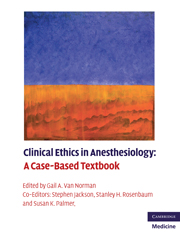20 results
Use of vitamin D supplements during infancy in an international feeding trial
-
- Journal:
- Public Health Nutrition / Volume 17 / Issue 4 / April 2014
- Published online by Cambridge University Press:
- 24 June 2013, pp. 810-822
-
- Article
-
- You have access
- HTML
- Export citation
4 - Research and publication
-
- Book:
- Clinical Ethics in Anesthesiology
- Published online:
- 05 March 2012
- Print publication:
- 28 October 2010, pp 161-216
-
- Chapter
- Export citation
3 - Pain management
-
- Book:
- Clinical Ethics in Anesthesiology
- Published online:
- 05 March 2012
- Print publication:
- 28 October 2010, pp 135-160
-
- Chapter
- Export citation
5 - Practice issues
-
- Book:
- Clinical Ethics in Anesthesiology
- Published online:
- 05 March 2012
- Print publication:
- 28 October 2010, pp 217-254
-
- Chapter
- Export citation
46 - Triage in civilian mass casualty situations
- from 6 - Anesthesiologists, the state, and society
-
-
- Book:
- Clinical Ethics in Anesthesiology
- Published online:
- 05 March 2012
- Print publication:
- 28 October 2010, pp 270-274
-
- Chapter
- Export citation
11 - The use of ethics consultation regarding consent and refusal
- from 1 - Consent and refusal
-
-
- Book:
- Clinical Ethics in Anesthesiology
- Published online:
- 05 March 2012
- Print publication:
- 28 October 2010, pp 64-68
-
- Chapter
- Export citation
Copyright page
-
- Book:
- Clinical Ethics in Anesthesiology
- Published online:
- 05 March 2012
- Print publication:
- 28 October 2010, pp iv-iv
-
- Chapter
- Export citation
Contents
-
- Book:
- Clinical Ethics in Anesthesiology
- Published online:
- 05 March 2012
- Print publication:
- 28 October 2010, pp vii-x
-
- Chapter
- Export citation
2 - End-of-life issues
-
- Book:
- Clinical Ethics in Anesthesiology
- Published online:
- 05 March 2012
- Print publication:
- 28 October 2010, pp 85-134
-
- Chapter
- Export citation
1 - Consent and refusal
-
- Book:
- Clinical Ethics in Anesthesiology
- Published online:
- 05 March 2012
- Print publication:
- 28 October 2010, pp 1-84
-
- Chapter
- Export citation
Clinical Ethics in Anesthesiology - Title page
-
-
- Book:
- Clinical Ethics in Anesthesiology
- Published online:
- 05 March 2012
- Print publication:
- 28 October 2010, pp iii-iii
-
- Chapter
- Export citation
Clinical Ethics in Anesthesiology - Half title page
-
- Book:
- Clinical Ethics in Anesthesiology
- Published online:
- 05 March 2012
- Print publication:
- 28 October 2010, pp i-ii
-
- Chapter
- Export citation
45 - Ethical principles regarding physician response to disasters: pandemics, natural disasters, and terrorism
- from 6 - Anesthesiologists, the state, and society
-
-
- Book:
- Clinical Ethics in Anesthesiology
- Published online:
- 05 March 2012
- Print publication:
- 28 October 2010, pp 266-269
-
- Chapter
- Export citation

Clinical Ethics in Anesthesiology
- A Case-Based Textbook
-
- Published online:
- 05 March 2012
- Print publication:
- 28 October 2010
Index
-
- Book:
- Clinical Ethics in Anesthesiology
- Published online:
- 05 March 2012
- Print publication:
- 28 October 2010, pp 292-298
-
- Chapter
- Export citation
13 - Communitarian values in medical decision-making: Native Americans
- from 1 - Consent and refusal
-
-
- Book:
- Clinical Ethics in Anesthesiology
- Published online:
- 05 March 2012
- Print publication:
- 28 October 2010, pp 74-78
-
- Chapter
- Export citation
6 - Anesthesiologists, the state, and society
-
- Book:
- Clinical Ethics in Anesthesiology
- Published online:
- 05 March 2012
- Print publication:
- 28 October 2010, pp 255-291
-
- Chapter
- Export citation
Dedication
-
- Book:
- Clinical Ethics in Anesthesiology
- Published online:
- 05 March 2012
- Print publication:
- 28 October 2010, pp v-vi
-
- Chapter
- Export citation
Contributors
-
-
- Book:
- Clinical Ethics in Anesthesiology
- Published online:
- 05 March 2012
- Print publication:
- 28 October 2010, pp xi-xiv
-
- Chapter
- Export citation
Contributors
-
-
- Book:
- Ultrasonography in Reproductive Medicine and Infertility
- Published online:
- 07 September 2011
- Print publication:
- 25 March 2010, pp ix-xii
-
- Chapter
- Export citation



